A record of outings 2016
by Hugh Deam
Donna's Autumn Outing
Saturday 1st October 2016
10:00 West Hanney
St James Gt (6) 18-1-9 in E · Oxon OX12 0LP
11:30 Marcham
All Saints (6) 8-1-4 in G · Oxon OX13 6NW
13:00 Appleton
The Plough Inn · Eaton Road · Oxon OX13 5JR
15:00 Stanford in the Vale
St Denys (8) 8-1-17 in G# · Oxon SN7 8HU
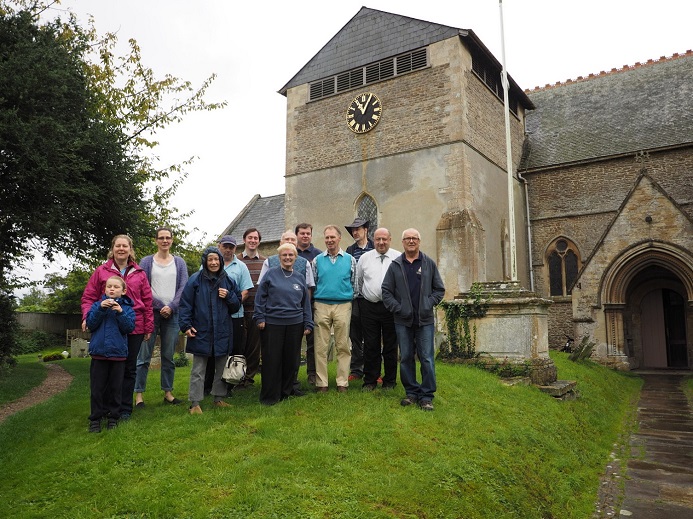
West Hanney
Janice Beale, Jonathon Beale, Donna Bennett, Jane Burgess, Ron Burgess, Hugh Deam, Steve Everett, Toby Goss, Michael Gurl, Judy Kirby, Paul Lucas, Colin Taylor, Jackie O' Hagan, John Pearce & Rosi Rollings.
Bob Major, Grandsire Triples, Cambridge, St Clement's & Little Bob Minor and Stedman Doubles.
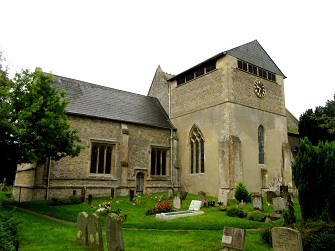
West Hanney · St James Gt
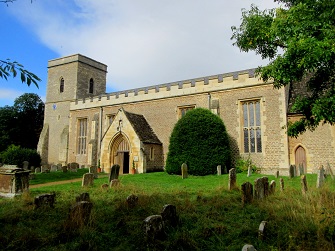
Marcham · All Saints
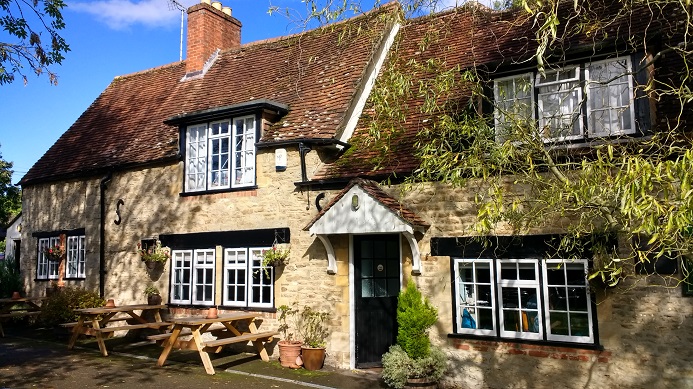
The Plough Inn · Appleton
West Hanney & Marcham See Saturday 20th April 1996 for details of the previous outing held here.
The Plough An excellent lunch was enjoyed at this late 17th century inn (1683), which thoroughly fits the bill as the quintessence of an English country pub, with low beams, rooms enhanced by idiosyncratic curios and a good beer garden to complement the whole.
Stanford in the Vale Referencing a stone ford, the affix denoting the position of the village in the Vale of the White Horse, the settlement was documented as Stanford in le Vale in 1496.
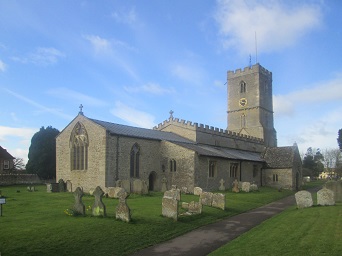 The village is situated just north of the source of the River Ock, a tributary of the River Thames, and is bordered on its other flanks by Stutfield Brook and Frogmore Brook. Up until the boundary reorganisations of 1974 the village was in Berkshire, although the economic and social ties with Oxford were long established and the local accent is what is generally considered to be rural Oxfordshire. The poet and songwriter, Pam Ayres was born in the village, honing her distinctive delivery at folk clubs in and around Oxford and then on Radio Oxford, finding national fame after winning Opportunity Knocks several weeks running. The parish church is situated on the western edge of the village green with the linden trees in the churchyard and on the green having been planted in 1897 to mark Queen Victoria's diamond jubilee. The oldest surviving parts of the church are the 12th century north and south doorways, with the west tower dating to the latter half of the 13th century at the time when major reconstruction of the church took place. The five earliest bells (3, 5, 6, 7, Tenor) all date to 1700, cast by Abraham Rudhall of Gloucester. The fourth is from the same foundry, dating to 1753 by Abel Rudhall. The treble and second were added by Mears & Stainbank (Whitechapel) in 1891.
The village is situated just north of the source of the River Ock, a tributary of the River Thames, and is bordered on its other flanks by Stutfield Brook and Frogmore Brook. Up until the boundary reorganisations of 1974 the village was in Berkshire, although the economic and social ties with Oxford were long established and the local accent is what is generally considered to be rural Oxfordshire. The poet and songwriter, Pam Ayres was born in the village, honing her distinctive delivery at folk clubs in and around Oxford and then on Radio Oxford, finding national fame after winning Opportunity Knocks several weeks running. The parish church is situated on the western edge of the village green with the linden trees in the churchyard and on the green having been planted in 1897 to mark Queen Victoria's diamond jubilee. The oldest surviving parts of the church are the 12th century north and south doorways, with the west tower dating to the latter half of the 13th century at the time when major reconstruction of the church took place. The five earliest bells (3, 5, 6, 7, Tenor) all date to 1700, cast by Abraham Rudhall of Gloucester. The fourth is from the same foundry, dating to 1753 by Abel Rudhall. The treble and second were added by Mears & Stainbank (Whitechapel) in 1891.

Stanford in the Vale · St Denys
Cornwall Ringing Weekend
Saturday 17th - Monday 19th September 2016
An outing by John Hearne
Alan Barsby, Margaret Carlyle, Hugh Deam, Stuart Gibson, John Hearn, Josie Irving, Gillian Loyd, Richard Loyd, Michael Probert, Philip Roberts, John Squirrell, Robert Tregillus & Darren Washington.
Stedman Caters & Triples, Grandsire Caters & Triples, Yorkshire Major, Cambridge Major & Minor, Superlative Major, Bristol Major, Double Norwich Major and Original Major.
Saturday 17th
10:00 Phillack
St Felicitas (8) 14-0-5 in F# · Corn TR27 5AD
11:15 Carbis Bay
St Anta & All Saints (10) 9-2-5 in G# · Corn TR26 2LD
14:15 Towednack
St Tewinock (8) 7-3-3 in Ab · Corn TR26 3AZ
15:15 Paul
St Pol de Leon (6) 14-2-5 in F · Corn TR19 6UA
16:30 St Buryan
St Buriana (6) 37-2-9 in C# · Corn TR19 6BZ
17:50 Penzance
St Mary V (8) 23-3-23 in D · Corn TR18 4AQ
Phillack The village is separated from the sea by a range of high sand dunes known as the Towans. Phillack can be traced back to one of the many Irish saints (St Felak) to make land on the north Cornish coast during the 6th century. The gruesomely named pub, The Bucket of Blood, has a violent history to match its name, primarily during the times of endemic smuggling when the bodies of murdered customs officers are reputed to have been hidden in barrels in the cellar. The church here was originally the parish church of Hayle, being built in the 15th century and rebuilt in 1856 by William White, with the tower remaining from the original structure. The bells all date to 1928, cast by Taylors of Loughborough.
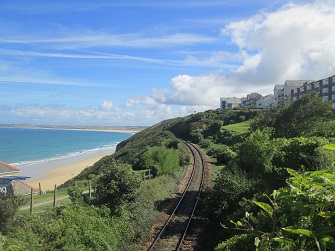
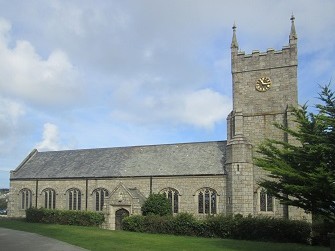 Carbis Bay This is a 19th century village named from an ancient farm recorded as Carbons, being the old Cornish for a causeway. Carbis Bay is one of the county's five Blue Flag beaches, boasting a wealth of golden sand which is lapped by the stunning turquoise waters of the Celtic Sea. The church is actually 20th century (1929) but constructed in a traditional Cornish style. All of the bells were cast at the Loughborough foundry, with the back eight bells dating to 1946 and the front two having been added in 1959.
Towednack The area directly surrounding the village still evidences the mining tradition associated with the county and indeed Towednack was a principal filming location for the 1970's BBC adaptation of Poldark. The church is primarily 13th century, built on the site of a former Celtic hermitage. The squat tower is reputed by local legend to have come about due to the Devil squatting on it every night during its construction to prevent it getting any higher. The back six bells were all cast by John Warner & Sons (5 – 8, 1905) (3 & 4, 1912), with the front two bells cast in 1947 by Gillett & Johnston, Croydon.
Paul is situated on high ground overlooking the famous fishing village of Mousehole (Mow-zel), with the 15th century church serving both communities. The dedication of the church is from the 5th century French missionary St Pol de Leon thus reflecting the similarities of this area to the Brittany region of France. With the proximity to the coast and hilly wooded areas to the rear of the village it comes as no surprise that dampness is an issue, something which becomes most apparent with the interior of the tower that is startling in the amount of greenery such as fern that has permeated through. Fortunately this makes merely for a talking point and doesn't effect the excellence of this set of bells.
St Buryan Taking its name from the female Celtic Christian missionary Buriana, the village is situated on the West Penwith peninsula. Distinctive granite cottages cluster around the circular graveyard of the 14th century church. Close to the village is a 5000+ year old stone circle (Boscawen-un) which legend states is the fate that befell maidens who danced on the Sabbath. This was the site of the first meeting of the Cornish Bards in 1928. The county's most famous comedian, Jethro, was born in the village and his father founded the famed Male Voice Choir here. Of the six bells in the tower the second is by far the oldest in dating to 1681. (4 & 5, John Warner, 1901). The other three bells are all from the Whitechapel foundry (Treble – 2001, Third -1992) and most notably the tenor, 1994, which at 37cwt makes this the heaviest six-bell tower in the world.
Carbis Bay This is a 19th century village named from an ancient farm recorded as Carbons, being the old Cornish for a causeway. Carbis Bay is one of the county's five Blue Flag beaches, boasting a wealth of golden sand which is lapped by the stunning turquoise waters of the Celtic Sea. The church is actually 20th century (1929) but constructed in a traditional Cornish style. All of the bells were cast at the Loughborough foundry, with the back eight bells dating to 1946 and the front two having been added in 1959.
Towednack The area directly surrounding the village still evidences the mining tradition associated with the county and indeed Towednack was a principal filming location for the 1970's BBC adaptation of Poldark. The church is primarily 13th century, built on the site of a former Celtic hermitage. The squat tower is reputed by local legend to have come about due to the Devil squatting on it every night during its construction to prevent it getting any higher. The back six bells were all cast by John Warner & Sons (5 – 8, 1905) (3 & 4, 1912), with the front two bells cast in 1947 by Gillett & Johnston, Croydon.
Paul is situated on high ground overlooking the famous fishing village of Mousehole (Mow-zel), with the 15th century church serving both communities. The dedication of the church is from the 5th century French missionary St Pol de Leon thus reflecting the similarities of this area to the Brittany region of France. With the proximity to the coast and hilly wooded areas to the rear of the village it comes as no surprise that dampness is an issue, something which becomes most apparent with the interior of the tower that is startling in the amount of greenery such as fern that has permeated through. Fortunately this makes merely for a talking point and doesn't effect the excellence of this set of bells.
St Buryan Taking its name from the female Celtic Christian missionary Buriana, the village is situated on the West Penwith peninsula. Distinctive granite cottages cluster around the circular graveyard of the 14th century church. Close to the village is a 5000+ year old stone circle (Boscawen-un) which legend states is the fate that befell maidens who danced on the Sabbath. This was the site of the first meeting of the Cornish Bards in 1928. The county's most famous comedian, Jethro, was born in the village and his father founded the famed Male Voice Choir here. Of the six bells in the tower the second is by far the oldest in dating to 1681. (4 & 5, John Warner, 1901). The other three bells are all from the Whitechapel foundry (Treble – 2001, Third -1992) and most notably the tenor, 1994, which at 37cwt makes this the heaviest six-bell tower in the world.
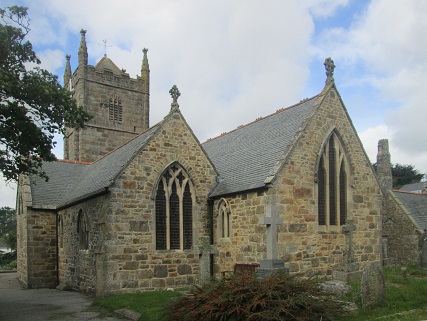
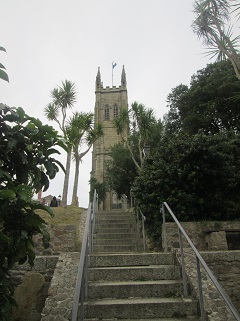 Penzance The most westerly town in the country, Penzance takes its name from the Cornish for Holy Headland, being documented as Pensans in 1284. The local economy has long been based around mining, fishing and agriculture. The town is set in a body of water that has St Michael's Mount as its jewel. A church has stood on the headland since the 12th century, although a huge fire in Victorian times required a rebuilding that was completed in 1895. All of the bells were cast in 1930 by Taylors of Loughborough. The tower furnishes views of the harbour and its ferry service which operates between the town and the Scilly Isles, plus the long promenade on the sea-front.
Penzance The most westerly town in the country, Penzance takes its name from the Cornish for Holy Headland, being documented as Pensans in 1284. The local economy has long been based around mining, fishing and agriculture. The town is set in a body of water that has St Michael's Mount as its jewel. A church has stood on the headland since the 12th century, although a huge fire in Victorian times required a rebuilding that was completed in 1895. All of the bells were cast in 1930 by Taylors of Loughborough. The tower furnishes views of the harbour and its ferry service which operates between the town and the Scilly Isles, plus the long promenade on the sea-front.

Carbis Bay

St Anta & All Saints

Phillack · St Felicitas

Penzance · St Mary
Sunday 18th
10:00 St Columb Major
St Columba (8) 12-2-4 in F · Corn TR9 6AE
13:30 St Austell
Holy Trinity (8) 18-2-5 in E · Corn PL25 5PN
15:30 Constantine
St Constantine (6) 7-2-14 in Bb · Corn TR11 5AW
17:00 Redruth
St Euny (8) 13cwt in G · Corn TR15 3BT
18:15 Tuckingmill
All Saints (8) 10-1-21 in G · Corn TR14 8RQ
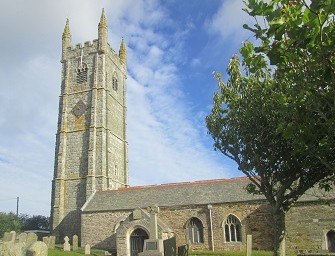
St Columb Major · St Columba
St Columb Major Situated in the Rialton Valley, the village is now effectively an inland suburb of Newquay. The Nobel Prize winning novelist William Golding (The Lord of the Flies) was born here and used this area to draw inspiration for several of his works. The church is built on the site of an an ancient barrow where pagan rites were celebrated. The present church and tower (the second tallest in the county at 115ft) are from the 15th century, there havng been as many as four previous rebuildings. The bells are rung from the ground floor and are among the best sounding in Cornwall.
St Austell As with so many other market towns and villages in the county St Austell developed on the back of tin and copper mining, but with the discovery of massive deposits of kaolin the focus turned to china clay. Besides its obvious popularity as porcelain, it also found a use in several other industries such as textiles, paper and pharmaceutical. By the 20th century the landscape had been altered dramatically, with numerous ranges of white-capped peaks created across the countryside, leading to the area being dubbed the "Cornish Alps". More recently the town has become nationally known for its brewery which was founded in 1851, its signature ale being Tribute. The original Norman church was dedicated to St Austol, the present building being from the 15th century, constructed of local Pentewan stone.
Constantine The village takes its name from the 6th century Cornish saint, although it was occupied considerably earlier than that time. Nearly all of the extractive industries (tin, copper, granite quarrying) have taken place here down the centuries, the largest mine having been Wheal Vyvyan. The church is a 15th century rebuilding of the Norman predecessor, with restoration work during the Victorian era. The three oldest bells (3, 4 & 5) date to 1809, cast at Whitechapel by Thomas Mears. The other three bells are from 1958, Taylors of Loughborough.
Redruth This heartland of the once dominant mining industry is now classified as a World Heritage Site, with much of the infrastructure preserved for future generations to draw inspiration from. The name of the town denotes a red ford, the stream running through the town having once become so discoloured by iron oxide. Prior to mining becoming so predominant the wool trade was the main source of employment during the Middle Ages. The unusual parish church dates from 1758, resembling a house that has been attached to the existing tower from around 1490. The earliest bells (4,5 & Tenor) are from Whitechapel, 1744, with the third, sixth and seventh from Pennington & Co, Exeter. The front two bells were added by Gillett & Johnston in 1935.
Tuckingmill The name of the village describes a fulling mill where homespun cloth was dipped, cleansed and dressed. The largest and deepest mine in Cornwall (Dolcoath Mine) operated close to the village, with the last mine to close being South Coity in 1998, although some of the mines are in reality mothballed in the hope of becoming economically viable in the future. The world's first safety fuse was manufactured here from 1831, being the invention of William Bickford.. The Norman revival style church was built at the behest of the Basset family in 1843/44, with the 12th century font having been transferred here from the medieval chapel at Menadarva. The bells are all from the Loughborough foundry, third to tenor, 1931, and the front two bells, 1936.
Monday 19th
10:00 Little Petherick
St Petrock (6) 6-2-22 in B · Corn PL27 7QT
11:00 St Issey
St Issey (6) 13-0-8 in F · Corn PL27 7QA
14:00 Egloshayle
St Petrock (8) 12-1-25 in F# · Corn PL27 6AQ
15:15 Bodmin
St Petroc (8) 17-0-11 in F · Corn PL31 2DT
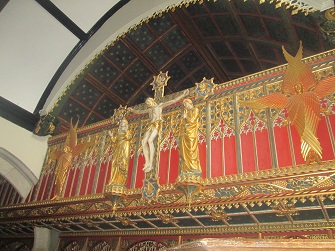
Little Petherick · St Petrock
Little Petherick The village sits on high ground overlooking the course of Little Petherick Creek, a tidal tributary of the River Camel. The church originates from the 14th century, with significant restorations in Victorian and Edwardian eras, with the rood screen by Ninian Comper being simply one of the finest in Britain. The back two bells are amongst the oldest to survive in the west country, the tenor dating to around 1399 and the fifth about twenty years later. The second is from 1907 by Llewellins & James, Bristol, and the other bells are all from the Loughborough foundry during the 20th century.
St Issey Taking its name from one of the many Irish missionaries to cross the Celtic Sea during the 6th century, a feast day in the name of St Ysa is held on the nearest Sunday to the 20th November. The parish church is partly Norman, being enlarged in the 15th century when the south aisle and tower were added. The tower has been rebuilt twice, the second time in 1871 after it had been struck by lightning and subsequently collapsed. All of the bells were cast by John Warner & Sons, Spitalfields (5 & Tenor – 1871, Treble to 4 – 1903). The 17th century inn, The Ring o' Bells, is situated directly across the road from the church and was responsible for providing a sumptuous lunch buffet for our group.
Egloshayle The name of the village is a perfectly accurate description, denoting its prominent church and the estuary which led to this being a thriving inland port for trade in tin, clay and wool. Originally dedicated to St Conan, the primarily perpendicular Gothic church contains a notable 15th century stone pulpit, with the 82ft three-stage tower housing eight bells. The four earliest bells (4 to 7) were cast in 1756 by Abel Rudhall, Gloucester. The third is from Whitechapel, 1876, and the others are from the Loughborough foundry, 1907. The village is one of the very few places to have their ringers immortalised in a popular local folk tune, namely The Ringers of Egloshayle.
Bodmin The former county town of Cornwall, Bodmin is the only Cornish town recorded in the Domesday Book. The former county prison (Bodmin Gaol) was the first English prison to have separate cells and was the scene of the last public hanging in England, now having been converted into a museum. The oldest part of the town is characterised by the houses being constructed of granite. The church, dating to 1469 – 1472, was the largest church in Cornwall until the construction of Truro Cathedral. The lower part of the tower remains from the original Norman church on this site, with the upper part dating to the time of the rebuilding of the church, although it has been minus a spire since 1699. All of the bells date to 1962 from the Loughborough foundry.
Roy Jones Memorial Ringing Morning
Saturday 20th August 2016
10:00 Twyford
Assumption of BVM (6) 12cwt in G · Bucks MK18 4ET
11:00 Marsh Gibbon
St Mary V (5) 13cwt in G · Bucks OX27 0HQ
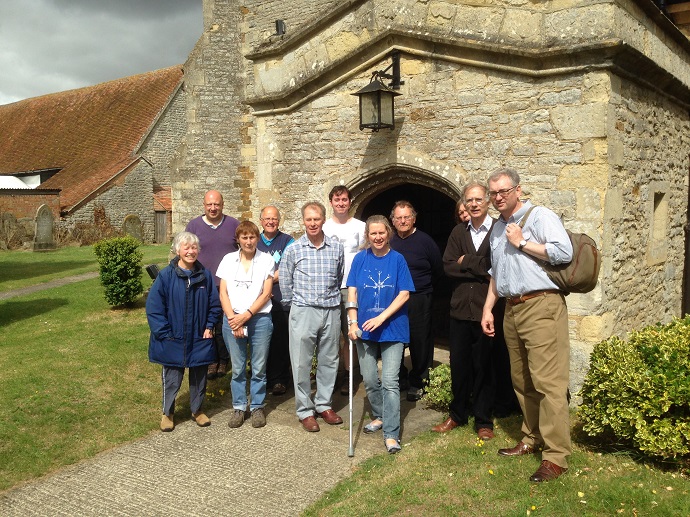
Marsh Gibbon
Hugh Deam, Neil Ephgrave, Toby Goss, Susan King, Judy Kirby, Alison Merryweather-Clarke, David Parkes, Lindsay Powell, Mike Probert, Colin Taylor, Simon King & Edwin Herring.
Plain Bob Minor, Stedman, St Simon's & Reverse Canterbury.
Describing a double ford, the parish of Twyford also now incorporates the hamlets of Charndon and Poundon. In the wake of the Norman Conquest the manor was gifted to Ralph de Feugeriis and remained in the keep of this family up until the Dissolution when it was forfeited to the Crown. Twyford became the seat of two notable English families, firstly the Giffords and then latterly the Wenman family. The Grade 1 Listed parish church is primarily 13th century, but retains a superb Norman arch. Amongst the numerous monuments within the church is a large Baroque monument in the south aisle commemorating Richard, 1st Viscount Wenman. The bells are rung from the ground floor with the fifth being the oldest, dating to 1597 and cast by an unknown bell-founder. The tenor was cast by W & J Taylor at their original foundry in Oxford, 1828. The fourth is from 1869, William Blew, Birmingham. The front three bells are from 1907, Gillett & Johnston, Croydon. Behind the fifth and tenor ropes is a towering steel ladder that leads up to the bells. Undoubtedly, confident handling is a necessity on these seldom rung bells. The village is populous and busy enough to support a pub, a community shop and a Chinese Take-Away.
Marsh Gibbon See 31st August 2014 for details.
Morning Outing
Saturday 30th July 2016
10:30 Eaton Bray
St Mary V (6) 9.5 cwt in A · Beds LU6 2DL
11:45 Edlesborough
St Mary V (6) 13-1-24 in F# · Bucks LU6 2EP
13:00 Edlesborough
The Traveller's Rest · Tring Road · Beds LU6 2EE
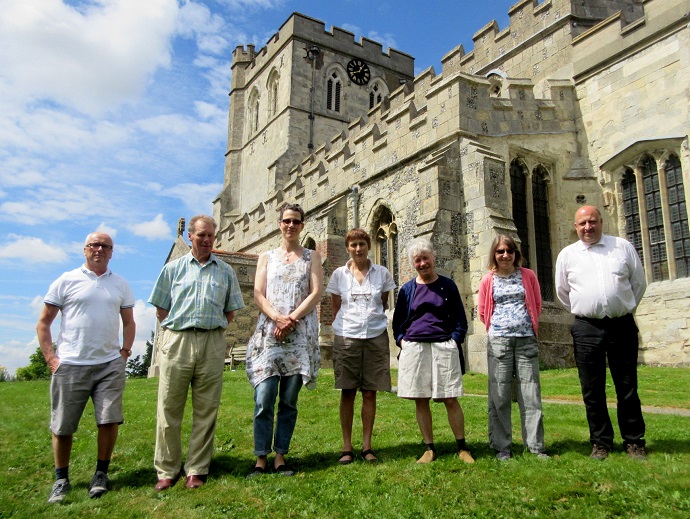
Some of the ringers before St Mary V · Edlesborough
Donna Bennett, Hugh Deam, Charlotte Furneaux, Susan King, Judy Kirby, Paul Lucas, Colin Taylor, John Plater & Michael Pearson.
Plain Bob Minor, Grandsire & All Saints.
Eaton Bray The Domesday Survey documents the settlement here as Eitone (a farmstead set on dry ground surrounded by marshland), with the later manorial affix from the Bray family, landowners here in the 15th century. Sir Reginald Bray fought alongside Henry Tudor at the Battle of Bosworth Field (1485) and is reputed to have been awarded this land after finding Richard III's crown on the battlefield and placing it on the head of the new king. The only evidence of the castle that stood here is a moat at Park Farm. During the Victorian era Arthur Macnamara, dubbed the mad squire of Billington, planned to build a mansion on the site to complement the many other grandly constructed dwellings of his across Britain. Having married into the aristocracy he was the epitome of the heavy drinking and callous squire, showing no compunction about evicting tenants on a whim, horse-whipping commoners and mowing them down if they got in the way of his horse and carriage. The mansion never came to fruition as he died a bankrupt having succumbed to cirrhosis of the liver. The parish church was built around 1205 for William de Cantilupe using stone quarried from nearby Totternhoe. The oldest of the bells is the fifth, cast in 1656 by William Whitmore of Watford. The tenor and fourth are both from the Drayton Parslow foundry, cast in 1705 (George Chancellor) and 1740 (Edward Hall) respectively. The front three bells are all from 1913, cast in Burford by Thomas Bond. The church contains a huge thatch-hook that was used in the event of a fire at the many nearby thatched cottages.
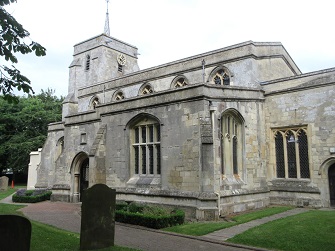
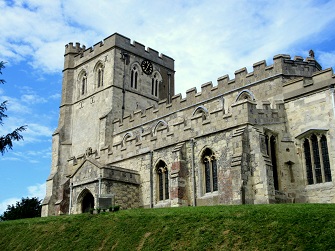 Edlesborough The village derives its name from a hill or barrow belonging to Eadwulf, an Anglo Saxon noble, being noted as Eddinberge in 1086. Across the years the village has gradually merged with its larger neighbour Eaton Bray. The Grade 1 listed church stands atop the largest barrow and dates to the 13th century in its earliest parts, nave, aisles and chancel being from this time. The west tower was added in the following century. A serious fire in 1828 resulted in an almost total restoration to the interior of the tower being required and hence all of the bells date to this time, cast at Whitechapel by Thomas Mears II and bearing inscriptions recording the fire. In 1975 the ecclesiastical parish merged with Eaton Bray and the church here became redundant by way of regular worship, although it has not been deconsecrated. Vested in the care of the Churches Conservation Trust the building continues to be one of the most striking church landmarks in the country.
Edlesborough The village derives its name from a hill or barrow belonging to Eadwulf, an Anglo Saxon noble, being noted as Eddinberge in 1086. Across the years the village has gradually merged with its larger neighbour Eaton Bray. The Grade 1 listed church stands atop the largest barrow and dates to the 13th century in its earliest parts, nave, aisles and chancel being from this time. The west tower was added in the following century. A serious fire in 1828 resulted in an almost total restoration to the interior of the tower being required and hence all of the bells date to this time, cast at Whitechapel by Thomas Mears II and bearing inscriptions recording the fire. In 1975 the ecclesiastical parish merged with Eaton Bray and the church here became redundant by way of regular worship, although it has not been deconsecrated. Vested in the care of the Churches Conservation Trust the building continues to be one of the most striking church landmarks in the country.

Eaton Bray · St Mary V

Edlesborough · St Mary V
Adrian Gray’s morning outing to Berkshire
Saturday 9th July 2016
10:00 Yattendon
St Peter & St Paul (6) 6-3-14 in Bb · Berks RG18 0UP
11:15 Englefield
St Mark (8) 8-0-11 in Ab · Berks RG7 5EN
12:15 Englefield
Stores & Tea Room · The Street · Berks RG7 5DU
Janice Beale, Jonathon Beale, Donna Bennett, Hugh Deam, Hayley Fisher, Adrian Gray, Simon King, Susan King, Judy Kirby, Ailsa Reid & Colin Taylor.
Grandsire Triples, Plain Bob Minor & Little Bob Minor.
Yattendon See Sunday 29th September 2002 for details.
Englefield Late in the 9th century the settlement here was known as Englafelda, this being as a direct result of the Anglo-Saxon defeat of the Danes in this area in AD 871, with a later notation in the Domesday Book as Englefel. The landowning family here took their name from the village and appointed themselves Sheriffs and Knights of the Shire throughout the Middle Ages.
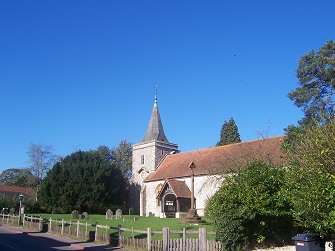
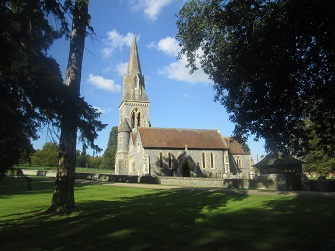 The violent upheavals of the Elizabethan era and the later Civil War years saw the house and lands change ownership several times as owners and residents found themselves on the losing side, or fall from regal favour in the case of the 2nd Earl of Essex. The Elizabethan manor house eventually passed into the ownership of the Benyon family, who paid for the rebuilding of the villagers houses during the 19th century.
The violent upheavals of the Elizabethan era and the later Civil War years saw the house and lands change ownership several times as owners and residents found themselves on the losing side, or fall from regal favour in the case of the 2nd Earl of Essex. The Elizabethan manor house eventually passed into the ownership of the Benyon family, who paid for the rebuilding of the villagers houses during the 19th century.
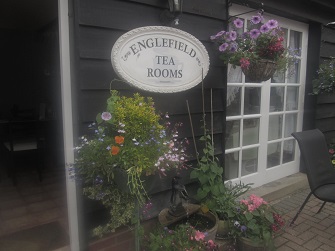 The late 12th century church was extensively rebuilt in 1857 to the designs of Sir George Gilbert Scott and reusing much original stonework and many of the old timbers for the roofing. The chapel contains memorials to the Englefield and Benyon families. The tower was added in 1868, but is constructed in the 13th century style and surmounted by a stone broach spire. The 20,000 acre estate is crisscrossed by a number of bridle paths and includes landscaped gardens, lakes and a deer park which borders the driveway to the church. At least a dozen major film and television productions have used this as a location in recent years (The King's Speech, The X-Men Franchise, Poirot, Marple and Midsomer Murders). There is a garden centre, plus shop and tearoom on the road through the village area of the estate, and as the weather on this day was fine we were able to enjoy lunch in the garden of the tea shop.
The late 12th century church was extensively rebuilt in 1857 to the designs of Sir George Gilbert Scott and reusing much original stonework and many of the old timbers for the roofing. The chapel contains memorials to the Englefield and Benyon families. The tower was added in 1868, but is constructed in the 13th century style and surmounted by a stone broach spire. The 20,000 acre estate is crisscrossed by a number of bridle paths and includes landscaped gardens, lakes and a deer park which borders the driveway to the church. At least a dozen major film and television productions have used this as a location in recent years (The King's Speech, The X-Men Franchise, Poirot, Marple and Midsomer Murders). There is a garden centre, plus shop and tearoom on the road through the village area of the estate, and as the weather on this day was fine we were able to enjoy lunch in the garden of the tea shop.

Yattendon · St Peter & St Paul

Englefield · St Mark

Englefield · Stores & Tea Room
Northamptonshire
Saturday 4th June 2016
10:00 Evenley
St George (5) 6-3-26 in A · Northants NN13 5SG
11:30 Whitfield
St John (6) 7-0-26 in Bb · Northants NN13 5TE
12:45 Stowe
Hayloft Cafe · Boycott Farm · Bucks MK18 5DJ
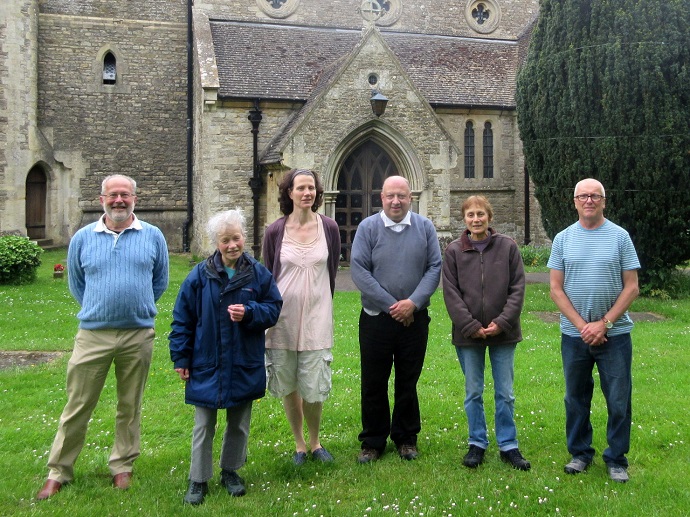
Evenley · St George
Donna Bennett, Hugh Deam, Simon King, Susan King, Judy Kirby, Paul Lucas, Paul Bennett & Ian Chappelle.
Plain Bob Minor, Stedman, St Simon's, St Martin's, Grandsire & Reverse Canterbury.
Evenley See Saturday 25th February 2006 for details.
Whitfield Denoting the Anglo Saxon description for white open land, the settlement here at the time of the Domesday Survey (1086) was noted as Witefelle. The village lies in the valley of the River Great Ouse, with the river acting as the county border with Buckinghamshire. In recent years the rolling countryside surrounding the village has gained a new landmark with the creation of Whitfield Racecourse which includes a large landscaped lake.
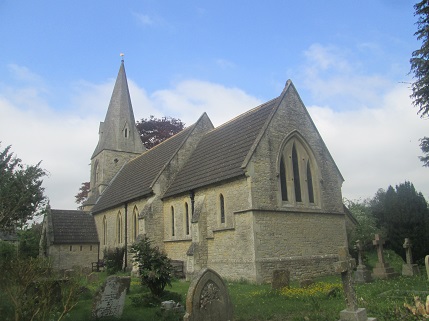
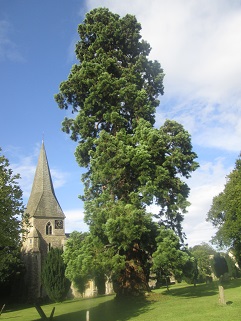 Besides regular point to point races, eventing competitions and exhibitions are also held here. The church is situated at the heart of the village, with across the road the prominent pub sign for the Rising Sun being the only reminder of its existence. A heavy gale on February 1st 1869 caused the west tower of the church to collapse, and consequently it exposed that the main body of the church was in a woeful state of decay. Both church and tower were rebuilt 1869/70 in the Early English style, comprised of limestone and being to the designs of Henry Woodyer of Guildford. Although the church comes under the Peterborough Diocese, its Patron is Worcester College, Oxford. The tower, which is capped by an octagonal broach spire, contains six bells cast by Taylor's of Loughborough in 1870. An excellent lunch was enjoyed in the Hayloft Cafe of Boycott Farm just to the east of Whitfield.
Besides regular point to point races, eventing competitions and exhibitions are also held here. The church is situated at the heart of the village, with across the road the prominent pub sign for the Rising Sun being the only reminder of its existence. A heavy gale on February 1st 1869 caused the west tower of the church to collapse, and consequently it exposed that the main body of the church was in a woeful state of decay. Both church and tower were rebuilt 1869/70 in the Early English style, comprised of limestone and being to the designs of Henry Woodyer of Guildford. Although the church comes under the Peterborough Diocese, its Patron is Worcester College, Oxford. The tower, which is capped by an octagonal broach spire, contains six bells cast by Taylor's of Loughborough in 1870. An excellent lunch was enjoyed in the Hayloft Cafe of Boycott Farm just to the east of Whitfield.

Whitfield · St John the Evangelist

Evenley · St George
Continuing our search for the source
Saturday 7th May 2016
of the river Cherwell
10:00 North Aston
St Mary V (6) 6-1-26 in B · Oxon OX25 6JA
11:15 Adderbury
St Mary (8) 24-0-14 in D · Oxon OX17 3LT
12:15 Banbury
St Mary (10) 17-0-9 in E · Oxon OX16 0AA
13:15 Banbury
White Horse · North Bar Street · Oxon OX16 0TS
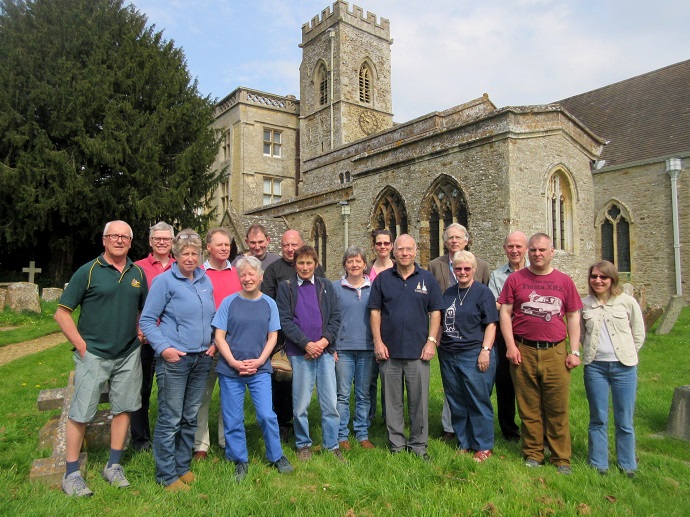
North Aston · St Mary V
Jane Burgess, Ron Burgess, Hugh Deam, Christine Fenn, Charlotte Furneaux, Brenda Gratwicke, Michael Haynes, John Hearn, Simon King, Susan King, Judy Kirby, Paul Lucas, Alison Merryweather-Clarke, Donna Murphy, Phil Sampson, Colin Taylor & Peter Trowles.
Grandsire Caters & Triples and Plain Bob Triples & Minor.
North Aston See Saturday 20th September 1986 for details.
Adderbury Divided by the Sor Brook, East and West Adderbury both possess a manor house and a village green. The 15th century tithe barn was built at the behest of New College, Oxford, which was also responsible for the construction of similar barns at Swalcliffe and Upper Heyford at that time. Adderbury House was built in the 17th century for the 1st Earl of Rochester. Two centuries later the house was owned by Major James Lamach whose horse Jeddah won the Epsom Derby in 1898 at odds of 100-1, and the construction of the village institute was as a direct result of this windfall.
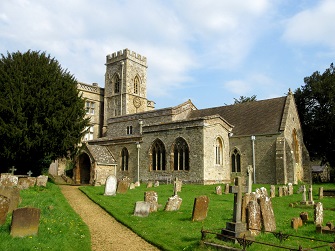
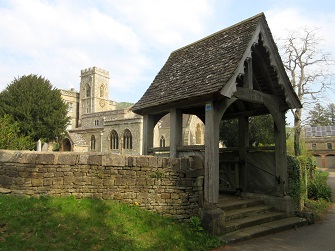 The village is a heartland of Morris Dancing, with a day of dance still held annually here. Adderbury's notable Quaker community led to a strong clock-making tradition in the area, with two of the families taking responsibility for the maintenance of the turret clock of the 13th century parish church. The cruciform church has a mighty west tower and spire which is the westerly start of the triumvirate of spires that were built to be seen from one to the next (Adderbury, Bloxham & King's Sutton). The tower houses one of the best sets of eight in the county, with most of the bells cast in 1789 by John Briant of Hertford. The third is from 1863 by George Mears, Whitechapel, and the sixth is from 1927 by John Taylor, Loughborough.
The village is a heartland of Morris Dancing, with a day of dance still held annually here. Adderbury's notable Quaker community led to a strong clock-making tradition in the area, with two of the families taking responsibility for the maintenance of the turret clock of the 13th century parish church. The cruciform church has a mighty west tower and spire which is the westerly start of the triumvirate of spires that were built to be seen from one to the next (Adderbury, Bloxham & King's Sutton). The tower houses one of the best sets of eight in the county, with most of the bells cast in 1789 by John Briant of Hertford. The third is from 1863 by George Mears, Whitechapel, and the sixth is from 1927 by John Taylor, Loughborough.
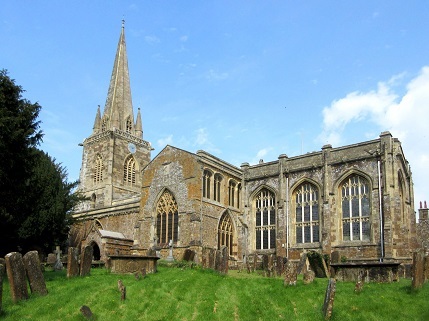
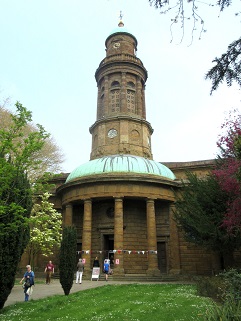 Banbury The earliest mention of a settlement here was in the 5th century, with the name deriving from the Anglo Saxon description for "Bana's Stronghold". The town's 12th century castle did not survive beyond the 17th century and today the Castle Quay Shopping Centre inhabits the site. The early growth as a market town came from sheep droving, although cattle later became the main stock in trade, indeed it became the largest market in the country at its height. Its closure was akin to the loss of blanket making in Witney in its bringing to a close a strong historical local chapter. Latterly, the aroma of coffee production has characterised the town for visitors, although the most renowned speciality of the town is the Banbury Cake, the secret recipe for which has been guardedly handed down to a precious few bakers over the past 350 years.
Banbury The earliest mention of a settlement here was in the 5th century, with the name deriving from the Anglo Saxon description for "Bana's Stronghold". The town's 12th century castle did not survive beyond the 17th century and today the Castle Quay Shopping Centre inhabits the site. The early growth as a market town came from sheep droving, although cattle later became the main stock in trade, indeed it became the largest market in the country at its height. Its closure was akin to the loss of blanket making in Witney in its bringing to a close a strong historical local chapter. Latterly, the aroma of coffee production has characterised the town for visitors, although the most renowned speciality of the town is the Banbury Cake, the secret recipe for which has been guardedly handed down to a precious few bakers over the past 350 years.
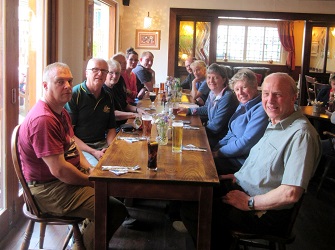 The present parish church dates to 1797 and was designed by Samuel Pepys Cockerell, the 12th century predecessor having become structurally unsound by this time. Work on the circular tower was not finished for another twenty years, the pepper-pot construction and its dome supported by twelve classical columns is thought to be modelled on Christopher Wren's baroque design of St Stephen's Church, Walbrook in the City of London. The ten bells were all either cast or re-cast in 1930 by John Taylor, Loughborough, and made for comfortable handling, making everyone feel at ease.
The White Horse pub is situated just a two minute walk to the north of the church and provided our party with an excellent lunch. As might be surmised, its name references the fine lady who rode a Cock Horse to Banbury Cross. Amongst the numerous candidates as the inspiration for this nursery rhyme are Queen Elizabeth I and Lady Godiva. A statue commemorating her journey stands next to the Banbury Cross at the central crossroads of the town and within sight of the church.
The present parish church dates to 1797 and was designed by Samuel Pepys Cockerell, the 12th century predecessor having become structurally unsound by this time. Work on the circular tower was not finished for another twenty years, the pepper-pot construction and its dome supported by twelve classical columns is thought to be modelled on Christopher Wren's baroque design of St Stephen's Church, Walbrook in the City of London. The ten bells were all either cast or re-cast in 1930 by John Taylor, Loughborough, and made for comfortable handling, making everyone feel at ease.
The White Horse pub is situated just a two minute walk to the north of the church and provided our party with an excellent lunch. As might be surmised, its name references the fine lady who rode a Cock Horse to Banbury Cross. Amongst the numerous candidates as the inspiration for this nursery rhyme are Queen Elizabeth I and Lady Godiva. A statue commemorating her journey stands next to the Banbury Cross at the central crossroads of the town and within sight of the church.

North Aston

St Mary V

Adderbury · St Mary

Banbury · St Mary

White Horse · Banbury
Colin Taylor's outing to the North Cotswolds
Saturday 2nd April 2016
10:00 Chipping Campden
St James (8) 22-1-18 in Eb · Glos GL55 6JN
11:45 Blockley
St Peter & St Paul (8) 16-0-27 in F · Glos GL56 9DN
13:00 Blockley
Village Shop & Cafe · Bell Lane · Glos GL56 9BB
14:15 Bourton on the Hill
St Lawrence (6) 11-1-27 in F · Glos GL56 9AH
15:30 Long Compton
St Peter & St Paul (6) 12-0-22 in F · Warks CV36 5JJ
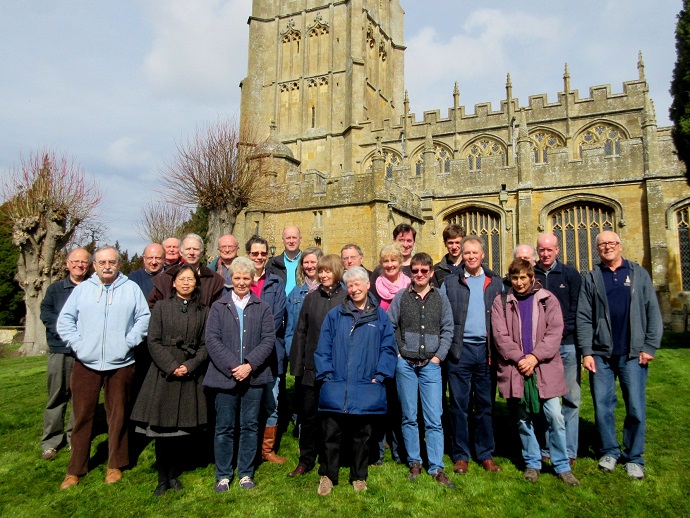
Before Chipping Campden · St James
Jesus Anonuevo, Hugh Deam, Clare Fairbairn, Malcolm Fairbairn, Hayley Fisher, Andrew Freer, Toby Goss, Tim Hilsdon, Simon King, Susan King, Judy Kirby, Ann Lloyd, Paul Lucas, Alison Merryweather-Clarke, Donna Murphy, David Parkes, Michael Probert, John Pusey, Sue Rhodes, Colin Taylor, Anthony Williamson, Kathy Xu & Richard Bennett.
Cambridge Major, Plain Bob Major, Stedman Triples, St Clement's Triples, Grandsire Triples, Norwich Minor & Cambridge Minor.
Chipping Campden Settled by the Saxons during the 7th century, this is the archetypal Cotswold market town, with its famous honey-coloured limestone buildings, from the 14th to 17th century, defining the broad High Street, thus making it one of the most photographed streets in the entire country, with no self respecting calendar of the Cotswolds being without it. Like most towns in the county, the wool trade played a major role in the evolvement of Chipping Campden, and latterly silk became a major employer. Although the silk mill closed in 1908, many craftsmen stayed on and since then it has been the home of the Guild of Handicrafts.
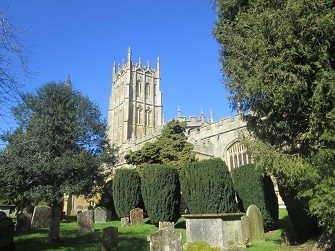
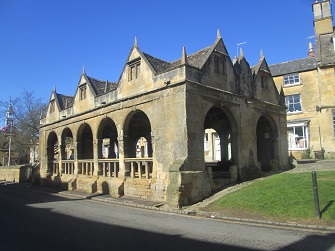 The 15th century parish church is a classic example of how the wool trade enabled construction on a grand scale in this area. Each of the lime trees leading from the churchyard entrance to the porch represents an apostle. The mighty tower rises to a height of 120ft and is capacious in the extreme. The oldest bells (4 & 5) are from the 17th century, cast by Richard Keene in Woodstock.
Blockley The village boundary is designated by two brooks, Blockley and Knee, both tributaries of the River Stour, and as a direct result the village gained a total of eight mills from the 13th century onwards to cater for the production of flour and latterly silk. For several years Blockley had a small zoo (Sleepy Hollow), which hit the headlines in the 1990s when it applied to accommodate big cats such as tigers and leopards just after two of its lynxes had escaped.
With the editors of the Guardian and Observer both living in the area the bad publicity was nationally highlighted and subsequent refusal of planning permission led to the closure of the zoo. Since the 1980s Blockley has been the home of Watsonian Squire who manufacture sidecars for Royal Enfield motorbikes. In 2010 the firm built seven specially designed sidecars to conjoin with existing Royal Enfield motorcycles for the seventh Harry Potter movie. The tower of the parish church was at this time swathed in scaffolding as some £120,000 is being spent on renovation work. The Community Shop and Cafe is handily situated at the entrance to the churchyard and saw us right for lunch.
The 15th century parish church is a classic example of how the wool trade enabled construction on a grand scale in this area. Each of the lime trees leading from the churchyard entrance to the porch represents an apostle. The mighty tower rises to a height of 120ft and is capacious in the extreme. The oldest bells (4 & 5) are from the 17th century, cast by Richard Keene in Woodstock.
Blockley The village boundary is designated by two brooks, Blockley and Knee, both tributaries of the River Stour, and as a direct result the village gained a total of eight mills from the 13th century onwards to cater for the production of flour and latterly silk. For several years Blockley had a small zoo (Sleepy Hollow), which hit the headlines in the 1990s when it applied to accommodate big cats such as tigers and leopards just after two of its lynxes had escaped.
With the editors of the Guardian and Observer both living in the area the bad publicity was nationally highlighted and subsequent refusal of planning permission led to the closure of the zoo. Since the 1980s Blockley has been the home of Watsonian Squire who manufacture sidecars for Royal Enfield motorbikes. In 2010 the firm built seven specially designed sidecars to conjoin with existing Royal Enfield motorcycles for the seventh Harry Potter movie. The tower of the parish church was at this time swathed in scaffolding as some £120,000 is being spent on renovation work. The Community Shop and Cafe is handily situated at the entrance to the churchyard and saw us right for lunch.
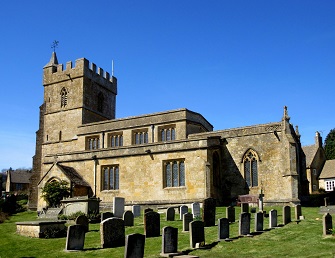
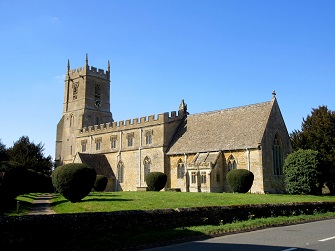 Bourton on the Hill As the name suggests, Bourton stands at a high point of the Cotswolds overlooking the River Evenlode and was historically utilised as a fortification. Bourton House is an 18th century manor house with a three acre garden of immense beauty and diversity. The popular tourist attractions Batsford Arboretum and Cotswold Falconry Centre are both close to the village. The 12th century church was originally dedicated to St Mary, with the embattled three-stage west tower added two centuries later. The back three bells are the oldest, cast in 1677 by Henry Bagley, Chacombe. The front two bells are by John Rudhall, Gloucester, and the third from Whitechapel, 1873.
Bourton on the Hill As the name suggests, Bourton stands at a high point of the Cotswolds overlooking the River Evenlode and was historically utilised as a fortification. Bourton House is an 18th century manor house with a three acre garden of immense beauty and diversity. The popular tourist attractions Batsford Arboretum and Cotswold Falconry Centre are both close to the village. The 12th century church was originally dedicated to St Mary, with the embattled three-stage west tower added two centuries later. The back three bells are the oldest, cast in 1677 by Henry Bagley, Chacombe. The front two bells are by John Rudhall, Gloucester, and the third from Whitechapel, 1873.
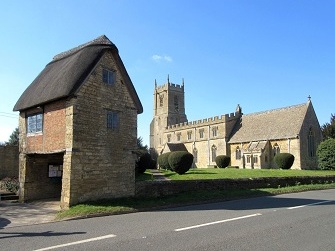
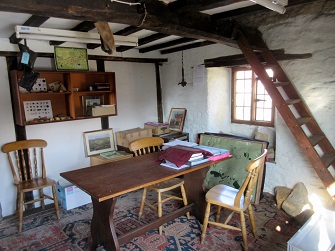 Long Compton The spelling of the village name has remained unaltered since 1299, denoting a farmstead set in a long valley. Just to the south of Long Compton are the Rollright Stones, a complex of three Neolithic and Bronze Age megalithic monuments. The original 6th century church stood a short distance to the west of the present 13th century building which is primarily constructed of limestone rubble. All six bells were cast at relatively adjacent foundries, Woodstock (Treble & 2, 1653), Chacombe (Tenor, 1731), Oxford (4, 1823), Burford (3 & 5, 1924). The churchyard is accessed via a truly magnificent two-storeyed thatched lych-gate, which our party was able to use as the location to enjoy two large chocolate cakes supplied by one of our group.
Long Compton The spelling of the village name has remained unaltered since 1299, denoting a farmstead set in a long valley. Just to the south of Long Compton are the Rollright Stones, a complex of three Neolithic and Bronze Age megalithic monuments. The original 6th century church stood a short distance to the west of the present 13th century building which is primarily constructed of limestone rubble. All six bells were cast at relatively adjacent foundries, Woodstock (Treble & 2, 1653), Chacombe (Tenor, 1731), Oxford (4, 1823), Burford (3 & 5, 1924). The churchyard is accessed via a truly magnificent two-storeyed thatched lych-gate, which our party was able to use as the location to enjoy two large chocolate cakes supplied by one of our group.

Chipping Campden · St James

Butter Market

Bourton on the Hill

Long Compton

Long Compton and its lych-gate

Within the gate
Wiltshire and Somerset
Saturday 5th March 2016
An outing by John Hearn
09:30 Westwood
St Mary V (6) 4-2-12 in D · Wilts BA15 2AF
10:45 Farleigh Hungerford
St Leonard (5) 4-3-3 in C · Som BA2 7RR
12:00 Norton St Philip
St Philip & St James (6) 8-2-10 in F# · Som BA2 7LU
13:00 Norton St Philip
George Inn · High Street · Som BA2 7LH
14:15 Radstock
St Nicholas (6) 11-0-25 in F# · Som BA3 3QG
15:30 Kilmersdon
St Peter & St Paul (6) 21-0-0 in Eb · Som BA3 5TD
17:00 Buckland Dinham
St Michael & AA (8) 10-2-19 in F · Som BA11 2QP
18:15 Warminster
St Denys (8) 24-3-8 in D · Wilts BA12 8PH
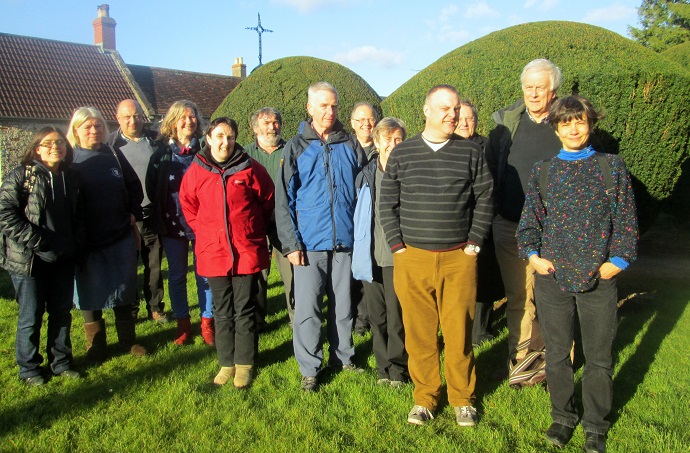
An eye to Apollo
Margaret Carlyle, Hugh Deam, Sylvia Harrington, Jacquie Hazell, Martha Hazell, John Hearn, Alison Merryweather-Clarke, David Parks, John Payne, Michael Probert, Brian Shacklady & Dorothy Steidinger.
Little Bob Major, Plain Bob Major, Stedman Triples, Grandsire Triples, Double Oxford Minor & Cambridge Minor.
Westwood The village is situated on a limestone plateau between the River Frome and River Avon and incorporates several early settlements (Lower & Upper Westwood, Avoncliff, Lye Green & Iford). Noted as Westwud in 987, the name denotes this was at that time a western wood of the Saxon royal estate of Bradford. The Avon Valley has long been characterised by pastoral and dairy farming, although as the name suggests Avoncliff is situated on a steep hillside outcrop overlooking the rest of the village. The 15th century Grade 1 Listed parish church is located in Lower Westwood and was restored in 1840. In keeping with the area it is constructed of limestone ashlar with a Perpendicular three-stage west tower. All six of the bells are from 1979, cast at the Whitechapel foundry.
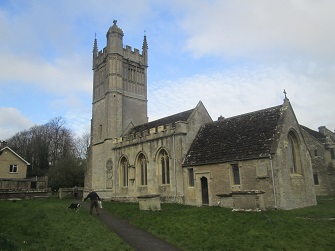
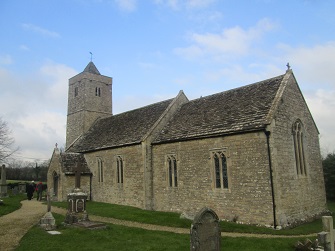 Farleigh Hungerford Nestling in a valley along the course of the River Frome, the early settlement here was known as Fearnlaeh (a woodland clearing growing with ferns). The manorial affix was originally Montfort (an influential Norman family), but in 1369 Sir Thomas de Hungerford bought the manor from the childless daughter of the deceased squire and subsequently ordered the construction of a castle here. His son Walter added an outer court that enclosed the original church which then became a family chapel, and as a result the present church was built nearby in 1443 to serve the parishioners. Apart from the treble (Loughborough 1999), all the other bells were cast at various foundries in the West Country (Frome, Nailsworth, Aldbourne & Bristol), with the fourth being heavier than the tenor.
Farleigh Hungerford Nestling in a valley along the course of the River Frome, the early settlement here was known as Fearnlaeh (a woodland clearing growing with ferns). The manorial affix was originally Montfort (an influential Norman family), but in 1369 Sir Thomas de Hungerford bought the manor from the childless daughter of the deceased squire and subsequently ordered the construction of a castle here. His son Walter added an outer court that enclosed the original church which then became a family chapel, and as a result the present church was built nearby in 1443 to serve the parishioners. Apart from the treble (Loughborough 1999), all the other bells were cast at various foundries in the West Country (Frome, Nailsworth, Aldbourne & Bristol), with the fourth being heavier than the tenor.
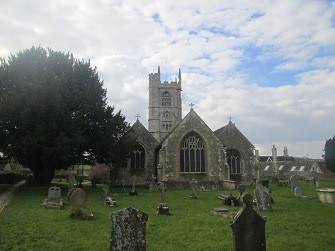
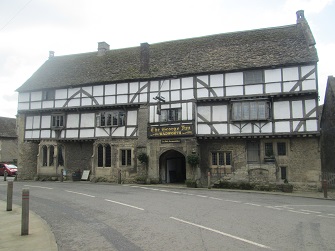 Norton St Philip The original settlement was situated a mile to the east of the current village on what was the Roman road between Bath and Poole. A priory was founded here in 1232 and existed until the Dissolution of 1540. The fortunes of the village were largely predicated on the wool trade, with a market long being held here. This area was at the centre of the Monmouth Rebellion, a further ultimately failed attempt to overthrow the popish James II, the previous plan having been the Rye House Plot. The infamous Judge Jefferies oversaw the execution of twelve rebels on the village common as part of the Bloody Assizes. The church is primarily 14th century, but heavily restored in Victorian times. All of the bells, bar the fourth, were cast at foundries in the West Country.
Radstock See Sat 23rd May 2015.
Norton St Philip The original settlement was situated a mile to the east of the current village on what was the Roman road between Bath and Poole. A priory was founded here in 1232 and existed until the Dissolution of 1540. The fortunes of the village were largely predicated on the wool trade, with a market long being held here. This area was at the centre of the Monmouth Rebellion, a further ultimately failed attempt to overthrow the popish James II, the previous plan having been the Rye House Plot. The infamous Judge Jefferies oversaw the execution of twelve rebels on the village common as part of the Bloody Assizes. The church is primarily 14th century, but heavily restored in Victorian times. All of the bells, bar the fourth, were cast at foundries in the West Country.
Radstock See Sat 23rd May 2015.
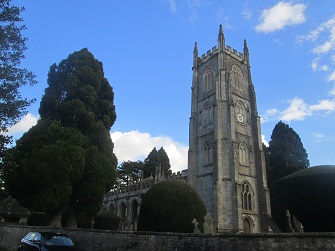
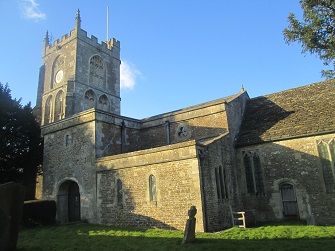 Kilmersdon Documented in the Domesday Book as Cheneneresdone (Cynemaer's Hill) the village incorporates the former hamlets of Charlton, South View and Green Parlour. A colliery was established here in 1875, although coal is known to have been extracted from this area since the 15th century, and probably as far back as Roman times. Kilmersdon Colliery was the last working colliery in Somerset until its closure in 1973. The church is primarily from the Victorian era, with the entrance to the churchyard graced by a fine triangular lychgate. The tower houses a heavy set of six bells, four of which were cast in the 18th century at foundries in Chew Stoke, Wincanton and Gloucester.
Buckland Dinham Known as Boclande by the 10th century, the estate had a royal diploma granting important rights and privileges during Anglo-Saxon times. The manorial affix denotes the Dinan family who were early landowners. The village is situated on the side of the hill known as Buckland Down, looking out over a vale created by several streams. The area had early habitation, with remains of an Iron Age hill-fort (Kingsdown Camp) still evident. The parish church dates to around 1200 in its earliest parts, with the north chapel added in 1325 and the west tower in 1480. The oldest bell (seventh) is from 1530, with the fourth and second from the following two centuries, cast in Warminster and Gloucester. The other five bells are from the 19th century by John Warner, London.
Warminster See Sat 20th March 2004.
Kilmersdon Documented in the Domesday Book as Cheneneresdone (Cynemaer's Hill) the village incorporates the former hamlets of Charlton, South View and Green Parlour. A colliery was established here in 1875, although coal is known to have been extracted from this area since the 15th century, and probably as far back as Roman times. Kilmersdon Colliery was the last working colliery in Somerset until its closure in 1973. The church is primarily from the Victorian era, with the entrance to the churchyard graced by a fine triangular lychgate. The tower houses a heavy set of six bells, four of which were cast in the 18th century at foundries in Chew Stoke, Wincanton and Gloucester.
Buckland Dinham Known as Boclande by the 10th century, the estate had a royal diploma granting important rights and privileges during Anglo-Saxon times. The manorial affix denotes the Dinan family who were early landowners. The village is situated on the side of the hill known as Buckland Down, looking out over a vale created by several streams. The area had early habitation, with remains of an Iron Age hill-fort (Kingsdown Camp) still evident. The parish church dates to around 1200 in its earliest parts, with the north chapel added in 1325 and the west tower in 1480. The oldest bell (seventh) is from 1530, with the fourth and second from the following two centuries, cast in Warminster and Gloucester. The other five bells are from the 19th century by John Warner, London.
Warminster See Sat 20th March 2004.

Westwood · St Mary V

Farleigh Hungerford

Norton St Philip

George Inn · Norton St Philip

Kilmersdon · St Peter & St Paul

Buckland Dinham · St Michael
Hugh's 30th Anniversary Outing
Saturday 27th February 2016
10:30 Hambleden
St Mary V (8) 11-0-25 in F# · Bucks RG9 6RP
12:00 Marlow
All Saints (8) 15-0-3 in F · Bucks SL7 2AA
13:15 Marlow
The Marlow Donkey · Station Road · Bucks SL7 1NW
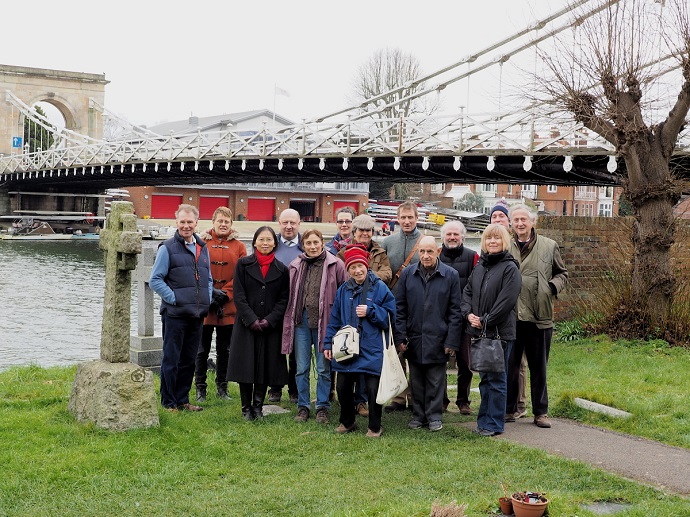
The ringers at Marlow
Anne Boulting, Rupert Boulting, Mary Carroll, Hugh Deam, Clare Fairbairn, Malcolm Fairbairn, Toby Goss, Anthony Hughes, Susan King, Judy Kirby, Bernard Masterman, Donna Murphy, Lindsay Powell, Colin Taylor & Kathy Xu.
Grandsire Triples & Plain Bob Triples.
Hambleden Way back in 1986, Hambleden and its church "the cathedral of the Chilterns" was the first location and tower of the first outing that I organised, and so it was humbling to still be doing this sort of thing thirty years on, and still having people turn up in good numbers. The present second and third bells were added by Hayward Mills Associates of Nottingham in 2006. If those two bells are notable for being relatively recent, then the tenor is even more notable for being in situ since around 1420, having been cast at a foundry in Wokingham. The church is richly endowed, primarily due to the founder of the WH Smith newsagents having owned the village, including a 16th century panel which started life as a bed-head for Cardinal Wolsey and a sea-chest taken to the Crimea by Lord Cardigan during the military campaign most remembered for the Charge of the Light Brigade.
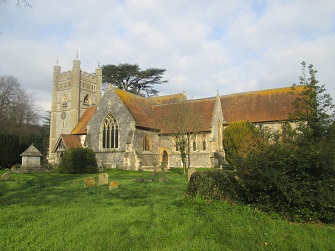
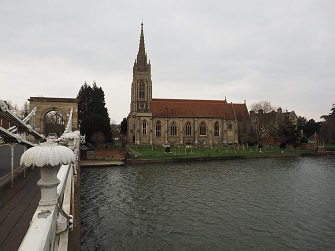 Avid television and movie viewers will doubtless have seen the village step back in time to an Edwardian era, and often draped in artificial snow, being a favourite location for adaptations of Jane Marple and Hercule Poirot whodunnits and many other screen dramatizations of period pieces (Band of Brothers, Sleepy Hollow, Into the Woods & Chitty Chitty Bang Bang). Hambleden has also featured in numerous contemporary British and American detective shows (Midsomer Murders, New Tricks, The Avengers & Crazy Like a Fox). A sunny, if bracing, morning made it possible for several of our party to enjoy tea and cake alfresco at the shop / cafe by the church prior to ringing.
Marlow Documented as Merelafan in 1015, the town derives its name from the Anglo-Saxon description for land remaining after the draining of a pool. From Norman times the borough grew in importance due to its location on the Reading to High Wycombe road where it crosses the River Thames. By 1227 it had been granted a market and was commonly referred to as Chipping Marlow. The present bridge is a suspension example designed by William Tierney Clark in 1832.
Avid television and movie viewers will doubtless have seen the village step back in time to an Edwardian era, and often draped in artificial snow, being a favourite location for adaptations of Jane Marple and Hercule Poirot whodunnits and many other screen dramatizations of period pieces (Band of Brothers, Sleepy Hollow, Into the Woods & Chitty Chitty Bang Bang). Hambleden has also featured in numerous contemporary British and American detective shows (Midsomer Murders, New Tricks, The Avengers & Crazy Like a Fox). A sunny, if bracing, morning made it possible for several of our party to enjoy tea and cake alfresco at the shop / cafe by the church prior to ringing.
Marlow Documented as Merelafan in 1015, the town derives its name from the Anglo-Saxon description for land remaining after the draining of a pool. From Norman times the borough grew in importance due to its location on the Reading to High Wycombe road where it crosses the River Thames. By 1227 it had been granted a market and was commonly referred to as Chipping Marlow. The present bridge is a suspension example designed by William Tierney Clark in 1832.
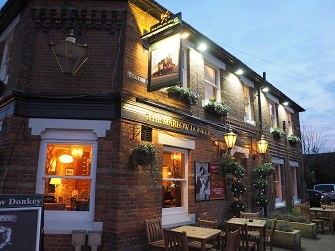 This was a forerunner of the larger Szechenyi Chain Bridge which spans the River Danube in Budapest, and consequently the town is twinned with Budavar which is a district of the Hungarian capital. Although not as widely known as Henley, the town once had two rowing regattas, and still hosts a regatta every June. Marlow is well known for its literary associations, with the Shelley's (Mary & Percy) both writing significant works whilst living here. Jerome K Jerome spent much time formulating his most famed work Three Men in a Boat in the riverside pubs of the town, and the poet TS Eliot moved here after the First World War. The parish church, built on the site of the 12th century original, dates to 1835. Although Marlow and Henley church towers bear little similarity in their design, with Marlow boasting a spire, they are both situated almost identically, by a bridge and overlooking the northern bank of the Thames. All of the bells have been cast at the Whitechapel foundry at various times since 1719.
The morning was rounded off in fine and tasty style by lunch at the distinctively named pub, The Marlow Donkey, the name of which references the nickname given to the railway Branch Line by locals soon after it opened in 1854.
This was a forerunner of the larger Szechenyi Chain Bridge which spans the River Danube in Budapest, and consequently the town is twinned with Budavar which is a district of the Hungarian capital. Although not as widely known as Henley, the town once had two rowing regattas, and still hosts a regatta every June. Marlow is well known for its literary associations, with the Shelley's (Mary & Percy) both writing significant works whilst living here. Jerome K Jerome spent much time formulating his most famed work Three Men in a Boat in the riverside pubs of the town, and the poet TS Eliot moved here after the First World War. The parish church, built on the site of the 12th century original, dates to 1835. Although Marlow and Henley church towers bear little similarity in their design, with Marlow boasting a spire, they are both situated almost identically, by a bridge and overlooking the northern bank of the Thames. All of the bells have been cast at the Whitechapel foundry at various times since 1719.
The morning was rounded off in fine and tasty style by lunch at the distinctively named pub, The Marlow Donkey, the name of which references the nickname given to the railway Branch Line by locals soon after it opened in 1854.

Hambleden · St Mary V

Marlow · All Saints

The Marlow Donkey

